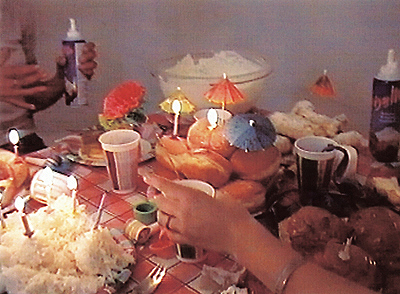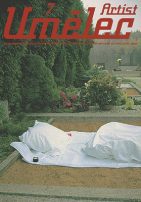| Revista Umělec 1999/7 >> Up to Your Ears (Contemporary Art in the Czech Republic) | Lista de todas las ediciones | ||||||||||||
|
|||||||||||||
Up to Your Ears (Contemporary Art in the Czech Republic)Revista Umělec 1999/701.07.1999 Lenka Lindaurová | reviews | en cs |
|||||||||||||
|
The number of young artists’ exhibitions which sprung up in recent months in the Czech Republic indicates that the art scene is trying to resolve something. On one hand, it is an expression of distrust to traditional ways of presentation in galleries and to communication with official structures (with artists organizing quite demanding events in alternative spaces and in public space - “99CZ”, “Public District” and “Visions”). On the other, it includes exploring communication in East European region which lacked artistic confrontation during the past decade (“Remote Similarities”, “Blue Fire - Biennial of Young Art”, “Public District”). Following a year when exhibitions Veronika’s Revenge and Dimensions Variable made us familiar with the incredible success of the Brit Pop scene and functioning of art operations and its close ties to commercial activities (especially in the fields of Pop music and design), there appears to be more of self-reflexive look at our experience “ten years later“, just a moment before start of the new millenium. Particular problems, however, still seem to prevail over efforts for integration into global territory. Overall social conservatism and isolationism prevent us from accepting multicultural model and stand against individual attempts of artists and curators to address this issue. The tendency to go back “to basements“, rent unused spaces, create one’s own anti-museum spaces represents a natural definition of the youngest generation of artists against large official exhibitions and at the same time the need for necessary presentation (the youngest and the less-known have no chance in getting into established galleries) and efforts to find an adequate place for works that do not feel to be Art. This also means searching for places in public space, places where artworks are invisible, where they become something that lies on the verge of being comprehensible, something that appears to be part of the commercial world. Projects that are hard to understand when presented in a gallery space, work in a completely different manner once placed on the street: they become part of a commonly communicated context, they are real posters, appeals, advertising attacks.
Public District Organized by Michal Koleček, curator of the Ústní nad Labem’s Filla Gallery, “Public District” exhibition was typical for its social subtext coming out of a concrete place where art works were displayed. Aggression, racism issues, bad taste, Bolshevik stereotypes, vulgarism of this industrial zone, they all appear in various works: a public appeal in the form of advertisement for the Ústí syndrome and the current culture of estrangement by Grzegorz Klaman, pseudo-information center by Roman Ondák, billboards promoting passive fitness equipment in the form of a wheelbarrow by Antal Lakner, or subtle irony of Marek Blažo who added one letter to the sign above a ZOO entrance, celebrating the arrival of the year 2000. Bojan Štokelj created virtual snapshots using obviously still topical Nazi syndrome which has a very impressive double meaning in the context of post-Communist countries. In a digitally manipulated video, you travel through landscapes but only from certain perspective can you read it: rocks in the form of McDonald’s logo, islands shaped as Swastika - all of this installed in the Union Bank. Other invisible installations in the city such as signs on trolley buses (by Pavel Kopřiva), forms at a post office, installations in shop windows (by Marek Blažo), stickers on poles and elsewhere (by Zdena Kolečková) show the possibility that one could be concentrated and inspired on every step, the possibility to see something new. 99CZ and A.D.S. Brno Exhibitions “99CZ” and “A.D.S. Brno” were conceived in a different style yet they also penetrated the public space. The visually attractive and politically topical St. Wenceslas riding an up-side-down horse installed at the bottom part of the Wenceslas Square in Prague by David Černý is mainly an ideal teaser for the laic viewer who had a chance to be unexpectedly exposed to contemporary art in this otherwise commercial zone of Baťa, McDonald’s and KFC stores. The organizer of the two exhibitions, ARTLAB, is an association of artists (Jiří David, Milan Salák, Jan Kadlec) and they set themselves a goal that even experienced curators did not dare to realize: to sum up Czech art in the 1990s. They claim a bit sophistically that the 90s “are a return to a concept with the post-modern experience“ and extra-gallery space is important for perception of the work itself, rather than atmosphere determined by art. It is fair to say that it was only a lack of experience that made it impossible for them to handle the challenge. Their subjective and limited approach is interesting but it definitely does not represent a precise recapitulation of the past ten years. The former printing plant on the Wenceslas Square provided only a minimum confrontation of diametrically different installations (Jan Kadlec - Stanislav Kolíbal - Vladimír Skrepl). We could see better or worse works by artists frequently exhibiting only during the past two years - furthermore, the works were up-to-date, prepared specifically for this exhibition. They thus could not serve as a survey of the 90s but only document a certain opinion in a certain period of time. They dealt generally with communication that contemporary art only reaches in a sort of second hand manner (e.g. video on never-ending kiss by Silver, video about what we always wanted to try by Pavel Humhal, video about shaving a corpse by Milena Dopitová, and video of a “tamagochi“ dog dying of hunger by Tomáš Mašín). Some of the objects suffered from bad juxtapositions: circular saws by Krištof Kintera were placed next to inflatable Malibu by Kateřina Vincourová, where they passed completely unnoticed. Works in the “A.D.S.” exhibition also worked more on their own than together, connected only by ironic and critical tone against commercialism - various types of gasoline by Jan Nálevka, HiFi by Nálevka and Milan Mikuláštík, emptied out McDonald’s memorial by Jiří Havlíček. Installation at the former Vyšehrad train station was so thin and trashy that the viewer walked through almost unpuzzled. The overall impression was pleasant that one could see so much art together but this “salon“ effect harmed the exhibitions. Less is sometimes more even in cases when good things prevail over the bad ones. Even an “unofficial“ salon remains to be a salon. Visions And what can be then said about “Visions” at the Roxy Club, could the “99CZ” creators rightfully ask? In this case, the exhibition was neither a salon or an attempt at exposition. Vidiny was an uncontrolled accumulation of works in the manner “he, who gives us a call, gets to hang something up“. It is thus impossible to evaluate the individual works as even the better ones drowned in this Czech mixed salad (e.g. contrast between Markéta Vaňková and Roman Trabura). Benefit of this style may lie in the fact that the exhibition showed completely unknown works if one could find them (Martin Horák). The Školská Street gallery housed the rest of the “Visions” in a pleasantly reconstructed space. The difference between the careless installation at Roxy and this gallery space is humorous while the same artists (Josef Bolf, Jan Šerých and others) appear terribly serious all of a sudden. This contrasting solution shows that the organizers were too determined by environment where they placed the works which could not hide lack of concept. Remote Similarities Compared with elemental thriving of young art which resembles some sort of organic matter whose differences may be only deciphered under a microscope, the exhibition “Remote Similariries Or Something Better Than Cosmetics”, put together by Jana and Jiří Ševčíks and Vladimír Beskid, appears like a piece of precise surgical work. In fact, the shows only share the attributes mentioned at the beginning of this text, the intention and selection criteria are different. “Remote Similarities” truly describe what those who are “beyond the limit of perception“ of art center have in common: peripheral experience producing a number of traumas and petty complexes which shape our incredibly subtle sensitivity leading to self-ironic vagaries (Vladimír Skrepl), soulful frivolity (Tomáš Vaněk, Roman Ondák), self-centered exhibitionism (Oleg Kulik), social precision (Vadim Fishkin, Miroslaw Balka, Ján Mančuška), suppressed seriousness (Kamera Skura), risky and total openness (Jasper Alvaer). Something better than cosmetics - this is a feeling shared by all of us who strive to maintain our pride in all phases of colonialism either for our own health’s sake or because we cherish our difference (since we cannot reach that big world around us). We are all alike in this territory although we refuse to admit it (as Leiderman inconspicuously hinted in his well-known Russian concept). Works (with the exception of not quite finished work by Boris Ondreička) are selected so that they culminate to the point that a viewer forgets about the subject of exploration and is drawn into the action. Blue Fire This approach, however, is not that of curators Olga Malá and Karel Srp who explore individual topical art historical issues which they present in the “Blue Fire - Biennial of Young Art”. The clutter of disparate works also more or less represents current Eastern scene with its common denominator being a hybrid approach to possibilities of art both visual and ideological. This mixture with which current artists work, however, is presented here as pathology which shocks and repels a common viewer. Pathological shift may be good for a work of art if it bares a substantial code. If it is just a mere game (Joanna Rajkowski), provocation (Artur Zmijewski), or naivete (Martin Kuriš), it is useless. Such empty masturbation completely overshadowed the few interesting and good works (Gábor Gerhes, Csaba Nemes, Kriszta Nagy, Anita Yarmolaewa). Without any reason, works taken out of other context are placed next to them (Kamera Skura, Michal Pěchouček). The number of voices, the noise they create hide but emptiness. It is neither shocking or moving, but above all it does not represent young art in Central and Eastern Europe. The End We should finally arrive at what issues are being resolved here. To snap up the answer with identity will not do (although the answer is tailor-made for the past ten years, for our local changes as well as changes of theoretical paradigms). It appears that contemporary artists rather try to find an answer for what art - or whatever we call it - means, whether it is effectively communicative, flexible, whether it should be comprehensible or not, for who it should be and where it should be shown, whether it is going to infiltrate levels that we have not yet defined, or whether we do not need to define them at all. The broad shores of current happening in the Czech Republic are pleasant although there is not much water in between them.
01.07.1999
Artículos recomendados
|
|||||||||||||













Comentarios
Actualmente no hay comentariosAgregar nuevo comentario